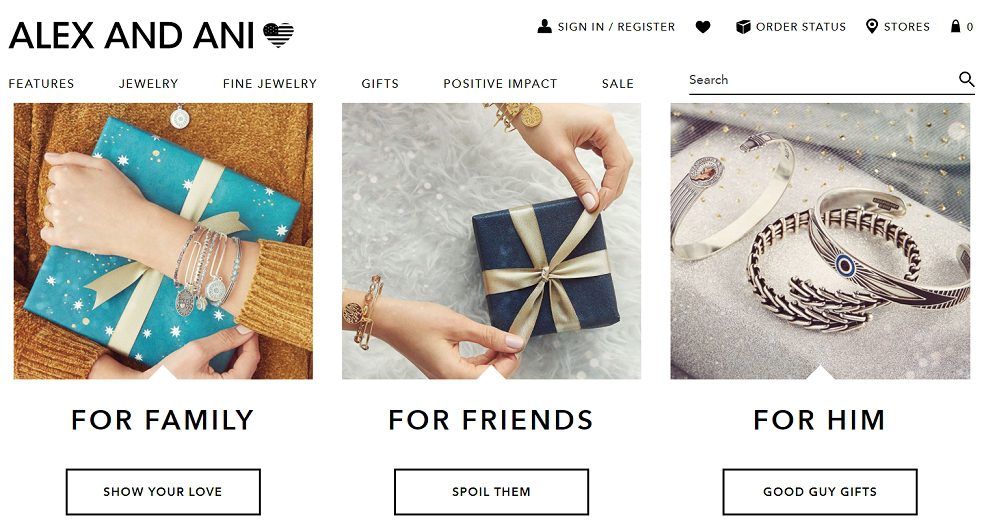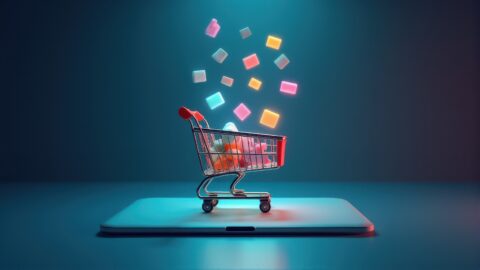 Personalization is a complex but necessary task, which can become even more complicated when the holiday season rolls around and gift-giving gets into high gear.
Personalization is a complex but necessary task, which can become even more complicated when the holiday season rolls around and gift-giving gets into high gear.
Alex and Ani, a brand built on the premise of customization, is tapping the benefits of personalization to help consumers choose the best gifts for their friends and family. In an exclusive interview with Retail TouchPoints, Katherine Bahamonde Monasebian, Head of Marketing and E-Commerce at Alex and Ani details why:
- Giftable, customizable products are the ultimate personalization drivers, not just during the holidays but throughout the year;
- “Non-tech” opportunities remain the low-hanging fruit in personalization, so retailers should avoid overlooking simple shopping preferences when searching for the next great platform; and
- Retailers with creative control over their overall messaging, distribution and manufacturing are well-positioned to both succeed this holiday and in 2018.
Retail TouchPoints (RTP): Personalization continues to drive a large portion of your marketing strategies through the year. How do you ramp it up during the holiday season?
Katherine Bahamonde Monasebian: Our product is interesting in that it’s giftable throughout the year, not just during the holidays. We view everything we do as customized — we encourage customers to pick pieces that fit their lifestyles, that have meaning for them personally. If you go into our stores, our store associates are trained to help customers find the symbols they need, and that will carry specific meaning to them. Products like our Chain Station Charm Necklaces, Zodiac, Birthstone, and Initials are all based on customization for individual customers.
We also have a Personal Blueprint app, where you put in your birthday and other factors and then it comes back with a list of products that are specific to what you need in the moment.
This whole ethos is about gifting, but leveraging data does shift during holidays because there’s a lot more noise and a lot more promotional activity.
Specifically, to start the holiday season, we gave early access to holiday products for last year’s buyers. We had the Nutcracker Charm Bangle — an exclusive 2017 bracelet — and we used the data of last year’s purchasers to give them early access to the limited-edition product. It’s fostered by the fact that we know which customers are gifting, so it’s driven by our database and our ability to target.
We worked on promotions that were gift-specific, and targeting gift-givers. For our media campaign, #SymbolRightNow, the first half is brand-building but the second half is product-focused gift ideas for gift givers, and that translates online.
Email is king, it’s our biggest digital marketing channel, and is a major piece of our messaging. Through our data, we’ve created different customer personas for styles and gift-giving needs which we launched through a takeover of our home page and our marketing channels.
RTP: How does product customization tie into personalization at Alex and Ani?
Monasebian: A lot of people look at customization and they think “engraving,” or they think literal in terms of embroidery or monogramming. Our definition of customization is that it’s how our customers can express their self-identity. Our customers can find product that’s unique to them.
Here’s an example of that experience: Let’s say you’re starting a new job and you need strength. We have the Lotus Peace Petals symbol that will give you that spiritual armor you need. If you’re going through a rough time, there’s the Path Of Life symbol that reminds you there are always twists and turns through each part of life.
It’s not just the product itself, it’s also the way you wear the product. For instance, our Chain Station Necklace Chains may start with a gemstone that represents the wearer’s birth month, and then the shopper can lay on their favorite color and a charity or animal that’s meaningful to them. With moveable beads, and an expandable chain, you can cluster as many charms as you want, wear it as a choker, a long piece. You can wear it your way, and that’s the identity of what we do.
RTP: What aspects of personalization are retailers not capitalizing on enough?
Monasebian: Everyone knows what the holy grail is — I know what your preferences are, when you wake up, when you go to McDonald’s — because all of that is being captured now in some way. But in the whole conversation of Big Data, it’s not all usable right now for a mid-sized retailer. The future is “hyper-personalized” targeted marketing, and the challenge for the future is that a lot of this data is still in different systems.
We don’t have data scientists that work with us, and as a consumer, when I see something online and it follows me around, it’s not terribly sophisticated.
The non-tech opportunities are the low-hanging fruit in personalization. It doesn’t take a lot: Who bought before? Let’s try to reengage with them. That’s versus being overly encumbered by the fact that we don’t have the systems or ability to segment to the degree that we would want for real true personalization. Sometimes, low sophistication efforts can be overlooked as everyone tries to keep up with the pace of change in the shifting landscape.
RTP: How do you leverage the right data to ensure that personalization initiatives are engaging the right consumers effectively?
Monasebian: It’s always with the goal of ‘What decision is this driving?’ and not just analysis for analysis’ sake. I always push the team when we do reporting; we’re not just looking for interesting information. We reactivate the buyers from the prior holiday season with our welcome series and our automated key triggered emails, which are a big percentage of our total sales generated through email.
We’re working on curating personalized content based on the data we’re collecting to create customer profiles and add product recommendations to our emails. Sometimes it’s data that we explicitly collected and sometimes it’s data that we infer from other tests. We’re using our email lists to do lookalike modeling on social, so it’s not just limited to email.
When we open a new store, we do geotargeted direct mail and geotargeted emails, which help guide our real estate strategies. We’re able to tell where a product is trending and where it’s not, and be able to use that for other areas of the business.
The challenge is that now that we’re in peak season, we’re laser-focused, we’re focused on more conversion-driving tactics through the harder working channels versus creative ideations. This isn’t the time that we’re doing a lot of that branding kind of work.
RTP: How have shifts in consumer spending affected Alex and Ani, such as brand presence in department stores and other third-party retailers?
Monasebian: It’s an interesting time in the retail landscape, especially when you hear about the “retail apocalypse” every day. I think we’re well-positioned as we have all the elements of a next-gen brand. We are vertically integrated, we don’t sell other people’s product, we control our manufacturing, we are cause-driven and we have a founder who is passionate about so much more than selling fashion jewelry. We’re made in the U.S. and we’re digitally progressive, so I think we’re in an incredible position to weather the storm and the overall landscape. I don’t think we’ve had to pivot as much as companies that don’t have as many of those foundational elements in their core operating model.
RTP: What advice to you have for retailers trying to stand out during the holiday season?
Monasebian: During the holidays, there’s so many competing messages out there. The brands that stay true to their reason for existence beyond just selling a product, and have some kind of creative control over their overall messaging, distribution and manufacturing, are well-positioned to win. But there is fierce competition in this quarter, and it’s important to stay very focused on cutting through that noise with messaging. Make it easy for customers; don’t make them think too much, and help gift givers through the journey.
RTP: As the Head of e-Commerce and Marketing for Alex and Ani, who are some inspiring figures or mentors that have led you to this point?
Monasebian: Carolyn Rafaelian, our founder and CEO, is a woman entrepreneur, and built this brand with an incredible vision about the future of retail. From a personal perspective, it’s been wonderful working with someone with that vision who’s built a company that she hopes to leave as a legacy for her daughters. It’s been inspiring working with so many incredible women who all believe in something more than retail as a vehicle for which we do other things, like our charity contributions.
Cindy DiPietrantonio, our President, is a very strong operator, serving as COO of The Jones Group for 20 years, and has been an incredible complement to Carolyn. For me personally, seeing two mothers in these positions become such powerhouses is very inspiring.
It’s been inspiring working with so many incredible women who all believe in our mission, and that our retail practices allow us to make profound donations and contributions to our charity partners, and local communities.
We spend so much time at work to be part of something more than just building a business, and I think that is shared by everyone at Alex and Ani, whether they work in Rhode Island, New York or the UK.
RTP: How did you first get into the retail business? What do you like best about your job?
Monasebian: I started out in investment banking and then I worked at Pepsi Co., so those two experiences were very foundation-setting. There’s no room for error in IB; it’s a client-facing business and you need to have attention to detail. You’re working very long hours to deliver, the stakes are high. So getting that financial grounding was a key experience.
Pepsi Co. was classically trained in strategic planning and financial modelling and brand profitability, all the characteristics of a blue chip company. But I have always gravitated toward businesses where I like the product and had an affinity for it.
I love retail; I love the industry. The changing consumer behavior has created such a large-scale shift in how we exist as humans. Do companies need to evolve as roles change? Yes. But will people always shop. Will people always want an email connection to why we buy? Yes. The digital landscape is always changing — just look at a little kid with an iPad. What is that going to be like in 10 or 20 years? What change is just around the corner for the world?













